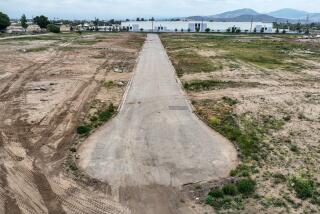Judge Upholds Malibu Civic Center Development Ban
- Share via
Settling one of the most contentious land-use issues since Malibu was incorporated in 1991, a Superior Court judge has upheld the city’s interim zoning ordinance, a ruling that stalls the development of a 125-acre parcel of land in the civic center area.
The Malibu Village Civic Assn., a group of 15 civic center landholders who had sued the city to clear the way for the mixed-use residential and commercial project, plans to appeal or ask Los Angeles Superior Court Judge Diane Wayne to reconsider her decision, which was made last week.
The ruling halts plans for what has been considered one of Southern California’s most ambitious coastal development projects in years. It would transform Malibu’s largely undeveloped civic center area, north of Pacific Coast Highway between Cross Creek and Stuart Ranch roads, into a mix of bungalows, estate homes, apartments and condominiums for up to 1,500 people, interspersed with shops and offices built around a village green.
The lawsuit was filed in April by the landholders group, which includes the largest commercial landholders in Malibu: the Konheim and Perenchio families of the Malibu Bay Co. The suit asked the court to overturn the zoning ordinance on the grounds that it does not comply with the state Environmental Quality Act. The act requires cities to conduct an environmental impact report before a development project or land-use ordinances are approved.
The ordinance outlaws residential development in the civic center, prohibits new multi-family housing in the city and places strict limits on other kinds of development. The ordinance was adopted in February, 1993, after a two-year building moratorium expired. It is a temporary measure while the city completes its General Plan, due in November.
The lawsuit asserted that the city violated state environmental laws in numerous technical ways, among them by adopting the ordinance without preparing an environmental impact report.
“The irony of the lawsuit is that the developer is trying to use an environmental act against an environmental City Council,” said Deputy City Atty. Christi Hogin. “(The State Environmental Quality Act) has been interpreted by the court to include adoption of an ordinance. And like a (development) project, the act requires that you do a study to determine that there will be no adverse effects on the environment. We did a study.”
Concern that the interim ordinance might be included in the city’s General Plan prompted the lawsuit, which has cost the city about $250,000, Hogin said.
“We’re looking at all the (legal) options,” said the landholders’ attorney, Allan J. Abshez. “(Judge Wayne) basically justified her decision based on the fact that the city’s zoning law was interim. Our concern is that it represents permanent policy direction.”
Hogin said that, by law, the City Council must review the interim zoning ordinance when the General Plan is adopted, and ensure that it is consistent with the plan’s building ordinances. But, “I don’t think that you are going to see a radical plan change between the interim zoning ordinance and the General Plan,” she said.
More to Read
Sign up for Essential California
The most important California stories and recommendations in your inbox every morning.
You may occasionally receive promotional content from the Los Angeles Times.










